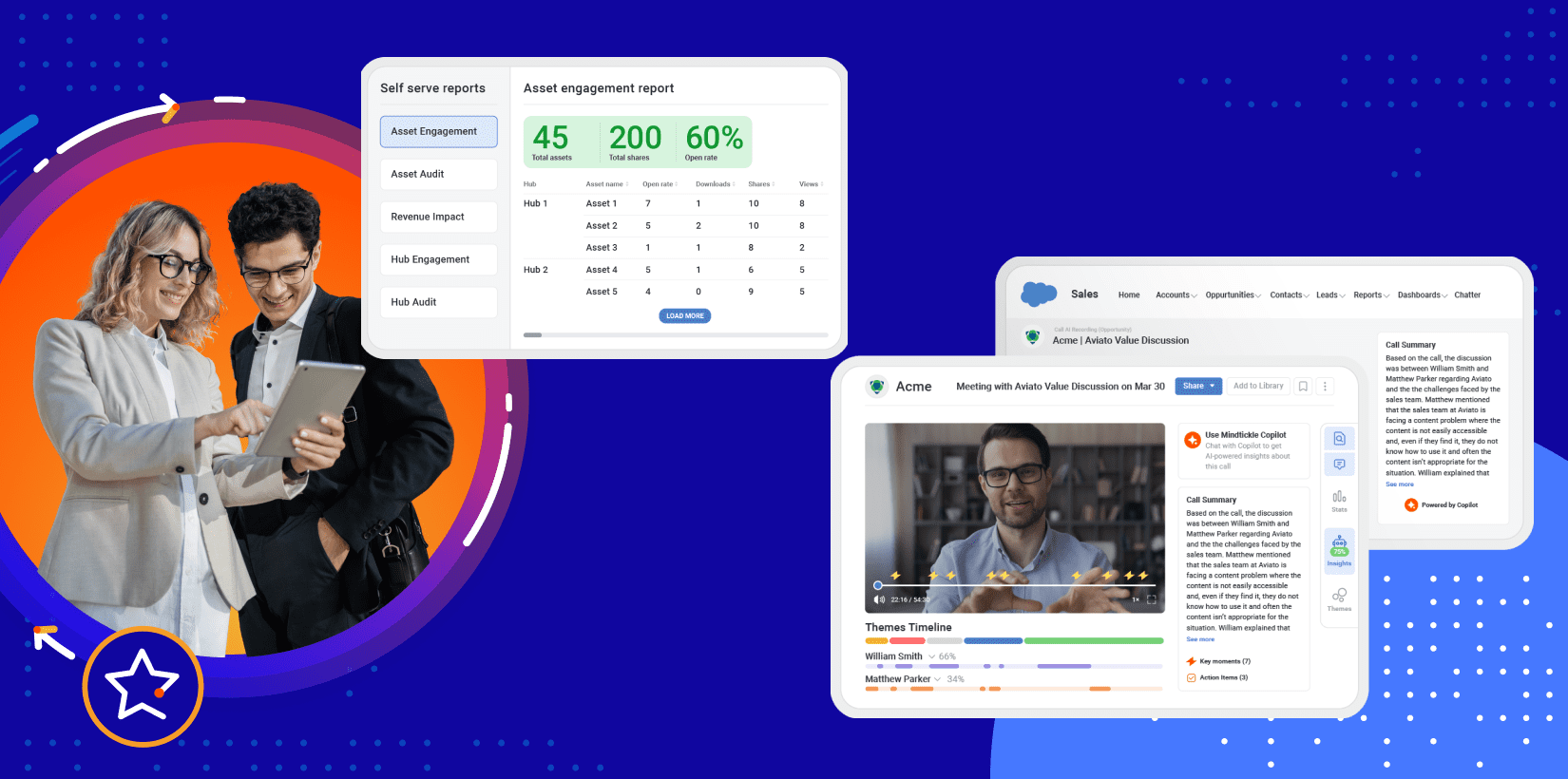In the world of business, change is the only constant. Organizations must keep a pulse on change and adapt accordingly. Otherwise, they’re sure to get left behind.
A business enablement mindset is a must for any modern organization. But what is it?
In this post, we’ll explore everything you need to know about business enablement and answer key questions, including:
- What is business enablement?
- How does it differ from sales enablement?
- What are its goals, and how is success measured?
- Who is responsible for it?
- How can business enablement benefit your organization?
You’ll walk away with a clear picture of what business enablement is – and how it helps ensure your organization is effective and efficient – both now and in the future.
What is business enablement?
Business enablement is a relatively new concept. So, let’s start by answering the question, “What is it?”
Every business in the world wants to be successful. That’s a given.
Of course, an organization’s ability to achieve its goals rests largely on its employees. But organizations often don’t equip employees with what they need to be effective and efficient.
A survey from Gartner found that nearly half (47%) of digital workers struggle to find the information needed to be effective in their roles. Furthermore, research from McKinsey & Company found that more than half of employees are “relatively unproductive” at work.
Research from McKinsey found that
When employees don’t have what they need, it negatively impacts the entire organization.
For an organization to achieve its goals, it must set up its employees for success. That’s where business enablement comes in.
It equips employees with the strategies, processes, people, and technology they need to be effective and efficient.
Successful initiatives reduce friction in employees’ workflows, making them more productive. When employees are more productive, the organization is better positioned to achieve its short- and long-term goals.
Business enablement initiatives are often “behind the scenes.” It can include anything from introducing a new technology that automates time-consuming processes to developing a new change management process.
Business vs sales enablement: what’s the difference?
The phrases “sales enablement” and “business enablement” are similar. So, it’s not surprising that people often confuse the two.
However, they aren’t the same thing.
Sales enablement is equipping the revenue organization with the right tools, sales training, information, coaching, and content they need to be effective and efficient in their roles. Modern B2B buyers have high expectations, and sales enablement helps sellers meet those expectations throughout the sales cycle.
While the concept of sales enablement is relatively new, it’s quickly grown in popularity. Per the 2024-2025 Chief Revenue Officer + Sales Leader Outlook Report, 84% of organizations invest in a sales enablement team. Typically, a sales enablement manager reports up to the organization’s Chief Revenue Officer. Sales enablement teams rely on sales enablement software to build, deliver, and measure sales enablement programs.
According to Mindtickle research,
Sales enablement teams focus on supporting the sales team. However, business enablement initiatives typically have a broader audience. These initiatives often impact the entire organization.
| Sales enablement | Business enablement | |
|---|---|---|
| Primary audience | Sales or revenue team | Entire organization |
| Goal | Increase sales productivity | Increase organizational effectiveness and efficiency |
| How they accomplish this goal | Equipping sellers with the tools, training, information, coaching, and content they need to engage buyers and close more deals. | Equipping all employees with the right tools, processes, resources, and strategies to be productive. |
| Ownership/responsible party | Sales enablement team, typically reporting up to the CRO. Sales enablement closely collaborates with sales and marketing teams. | Cross-functional |
What are the goals of business enablement?
Ultimately, the goal is to ensure the organization can be as effective and efficient as possible. Business enablement achieves this goal by equipping teams with the right tools, processes, resources, and strategies to eliminate friction and increase productivity.
When employees have what they need to be effective and efficient, the entire organization is more effective and efficient. In addition, the entire organization is aligned around the customer, which means it’s better equipped to meet customers’ needs and expectations. As a result, sales and retention will soar.
What are the performance metrics involved in business enablement?
Organizations can’t simply launch an initiative and hope it’s successful. Instead, they must measure its impact and optimize accordingly.
Establishing goals is the foundational first step of developing an initiative. Then, you can monitor key metrics to see whether your initiative is or isn’t achieving those goals.
But what business enablement metrics do you need to track? It depends on the goals of your project. However, nearly all business enablement initiatives aim to save time and money. So be sure to track metrics to determine whether or not you’re achieving those objectives.
Other metrics that may be measured include:
- Employee productivity
- Employee satisfaction
- Customer satisfaction
- Customer retention
With consistent measurement, you can identify whether your program is effective and what you can optimize to improve performance.
Who is responsible for business enablement?
Not surprisingly, sales enablement is driven by a dedicated sales enablement team. But who is responsible for business enablement? In other words, who are business enablement specialists, and what are different functions?
Typically, business enablement is a cross-functional effort. The exact teams that are involved vary depending on the initiative. However, there are typically a few groups of people involved:
This is the person (or people) leading a specific initiative. These specialists are responsible for driving collaboration and ensuring the project’s success. Depending on the initiative, the project owner can hail from any number of teams. For example, someone from human resources may be the project owner for a new payroll initiative. A representative from IT would likely lead an initiative focused on rolling out new technology.
These people are expected to adopt a new business enablement initiative or tool. They could be all employees or a subset, such as a specific department.
Typically, this is the person responsible for approving a business enablement initiative. Often, it is the head of finance or IT. Gaining this person’s buy-in increases your likelihood of getting buy-in across the entire leadership team and the organization as a whole.
What are the benefits of business enablement?
Today, a growing number of organizations are adopting a business enablement mindset. That’s not surprising. Business enablement – when it’s done well – can deliver many benefits to the business.
Alignment across the organization
Each team within the organization is focused on their own projects and initiatives. But all too often, these teams work in silos.
It can unite the entire organization toward a common goal. In addition, a business enablement initiative can bring together teams that don’t typically work together. For example, a project may be led by a team composed of members from IT, customer service, sales, marketing, and finance.
Better communication across different departments
Effective communication within a team and across the organization is key. But it can be challenging, especially when teams aren’t working in the same physical location.
Business enablement initiatives can improve internal communication. For example, you might roll out new technology to keep teams aligned on key projects. Better communication will drive better business outcomes.
Improved operational efficiency
There are only so many hours in the day, and you want your employees to make the most of them. But often, they get bogged down by time-consuming, repetitive work.
Business enablement can streamline or even automate repetitive, time-consuming tasks and admin work. That means your employees have more time to make progress on meaningful work.
That means your entire organization can move closer to its goals – faster.
Increased employee satisfaction
Employees with the right tools and processes to do their jobs are more satisfied at work. Satisfied workers are more productive – and more likely to stick around long-term.
A competitive advantage
Customers’ needs and expectations are always evolving. It’s important to understand these expectations and adapt accordingly.
Businesses can leverage business enablement to ensure the organization is aligned with customers’ needs and equipped to meet those needs.
For example, according to Gartner, 75% of B2B buyers prefer a rep-free sales experience. An organization can develop behind-the-scenes processes and leverage new technology to ensure the entire organization can meet customers’ expectations and preferences. If that company’s initiatives are a success, they’ll set it apart from the competition, making it easier to grow sales.
Increased customer retention
Winning new customers is important. It’s equally important to retain existing customers.
Business enablement initiatives enable teams to align around serving the customer. This will increase customer satisfaction, which will boost customer retention. In addition, customers are more likely to recommend the business to others, which will increase referrals.
It’s time to adopt a business enablement mindset
Business enablement is a relatively new concept. But a growing number of businesses are adopting it.
Equipping employees with the tools and processes they need to succeed will increase the organization’s effectiveness and efficiency. In addition, employees will be better equipped to serve customers, increasing customer acquisition and retention.
Business enablement and sales enablement aren’t the same thing. However, a solid sales enablement strategy – paired with the right technology – is a key way to boost sales productivity.
Today, winning revenue teams leverage Mindtickle’s integrated sales productivity platform to power their sales enablement programs.
Sales Enablement with Mindtickle
With Mindtickle, sellers can access the training, content, enablement, coaching, and call insights they need to be successful – all from one platform.
Book Your Demo


 By Poornima Mohandas
By Poornima Mohandas
 By Rahul Mathew
By Rahul Mathew
 By Christian Pieper
By Christian Pieper